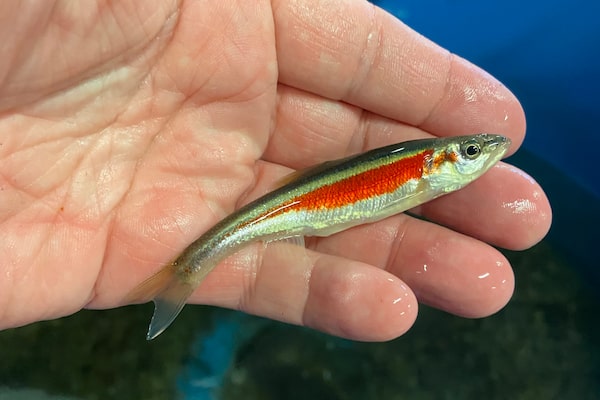
A Redside dace that was raised as part of a captive breeding program at the University of Windsor's Freshwater Restoration Ecology Centre, where researchers are studying the feasibility of species re-introduction.Krystal Athanassiou/Supplied
Anyway you look at it, the Redside dace is an odd fish.
Listed as an endangered species in Ontario, it lives in streams around the Greater Toronto Area and is known for leaping out of the water to snag flying insects with its gaping mouth. Despite its exotic dining habits and brilliant red stripes, the palm-size fish is a rare sight, most often seen as a brief flash of scarlet when swimming in sunlit waters.
Now, the Redside dace has been singled out by Ontario’s government in a way that scientists and others say will further imperil its future in one of the most ecologically stressed parts of the country.
On Tuesday, more than 60 conservation groups submitted their joint response to changes the province has proposed to its Endangered Species Act. If made law, the groups say, the changes will permit development in areas that are currently viable for the fish, along with additional measures that would affect several other species.
“There’s no doubt that these changes would contribute to the ongoing decline of Redside dace through further damage and destruction of habitat,” said Anne Bell, director of conservation and education for Ontario Nature, which topped the list of respondents on the joint submission.
Other experts, including university researchers who study the species, have separately provided their comments to Ontario’s Environment, Conservation and Parks Minister Andrea Khanjin.
Among their chief concerns is the first item on the province’s wish list, which is to halve the time period in which an area where the Red side dace has previously been seen is considered to be occupied habitat. The current law uses 20 years as its guidepost – a period adopted by the U.S.-Canadian biodiversity data organization NatureServe. The province would reduce this to ten years, which means a location where the fish has been seen as recently at 2013 would be fair game for construction projects.
“The 20-year period is particularly important in Canada because we have very limited resources to carry out this monitoring,” said Nicholas Mandrak, a professor at the University of Toronto who specializes in freshwater fish ecology. “We may not even sample a site in 20 years and there are many we have not sampled in the last ten years.”
In their joint submission, the conservation groups noted that in two watersheds in Halton Region, the number of locations that are deemed occupied by Redside dace would shrink from 40 to 14 under the proposed changes.
The province would also limit species recovery efforts to waterways that are directly adjacent to those that are currently occupied by Redside dace. At present, the province’s own recovery strategy for the species calls on all upstream headwaters of Redside dace habitat as well as historically occupied waters where there is a high likelihood of rehabilitation be considered habitat.
In a response to questions from The Globe and Mail, the ministry did not directly address the shortened time frame but said in a statement that the changes it is pursuing would allow the province to focus protections where they are most needed.
With respect to Redside dace, “All areas currently occupied by the species will continue to be protected, along with surrounding recovery habitat that is suitable for occupation,” said Lindsay Davidson, a spokesperson for the ministry.
Mr. Davidson added that the province would also protect the species in any areas where it has been reintroduced.
Researchers at the University of Windsor are currently exploring the feasibility of reintroducing the species to parts of its former habitat.
Under current law, the province is required to provide for successful rehabilitation of habitat for Redside dace. Based on its proposal, what the province would prefer instead is to pursue species recovery only in areas that are “currently suitable.”
Those who oppose the changes argue that this runs counter to the intentions of the Endangered Species Act, which includes promoting species recovery.
Mark Heaton, who works with the conservation group Ontario Streams and who chairs a regular meeting of individuals involved in Redside dace recovery, said the changes are not well supported by what is known about the state of the species.
“The science says you shouldn’t do it,” said Mr. Heaton, who was previously a fish and wildlife biologist with the province for 35 years and who led the development of its recovery strategy for the species.
Conservation groups have been wary of moves to weaken the province’s species law as part of Premier Doug Ford’s promise to open more land for building and roadways, including a plan to build Highway 413 northwest of Toronto. The project is currently in the midst of an environmental assessment.
At a news conference in Brampton, Ms. Khanjin said the government would be moving some projects to a streamlined form of environmental assessment. She said those projects would still be subject to the provisions of the Endangered Species Act.
However, that still leaves open the door to changing the law and to exemptions that accelerate approvals for projects. For example, another of the adjustments the province is proposing would extend various exemptions to the law to those species that were newly listed as endangered in Ontario as of 2023.
In 2021, the province’s auditor-general issued a report criticizing the Environment Ministry’s lack of a longer-term plan to improve the state of the province’s species at risk.